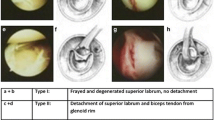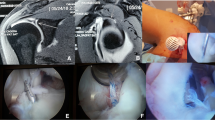Abstract
Background
Superior labrum anterior to posterior (SLAP) tears are a very common shoulder injury. The success rate of SLAP repair, particularly in the throwing athlete, has been variable in the literature.
Questions/Purposes
The purpose of this systematic review was to evaluate the reported post-operative outcomes of management techniques for failed SLAP repair.
Methods
The electronic databases MEDLINE, Embase, and PubMed were searched for relevant studies, and pertinent data was abstracted. Only studies reporting outcomes of management techniques for failed SLAP repairs were included.
Results
A total of 10 studies (levels III to IV) evaluating 176 patients were included in this systematic review. Most subjects were male (86.6%), with a mean age at surgery of 36.3 years (range, 17 to 67 years). The most commonly reported reason for failed SLAP repair was persistent post-operative mechanical symptoms after index SLAP repair. Common techniques used in the management of failed SLAP repair include biceps tenodesis and revision SLAP repair. Return to activity was significantly higher after biceps tenodesis than after arthroscopic revision SLAP repair. However, compared to primary SLAP repair, biceps tenodesis demonstrated no statistically significant differences in return to work rates. Complications reported in one case were resolved post-operatively, and there was no reported revision failure or reoperation after revision surgery.
Conclusion
The most common reason for failed SLAP repair is persistent post-operative mechanical symptoms. Revision surgery for failed SLAP repair has a high success rate. The rate of return to activity after biceps tenodesis was significantly higher than the rate after revision SLAP repair. Large high-quality randomized trials are required to provide definitive evidence to support the optimal treatment for failed SLAP repair.

Similar content being viewed by others
References
Andrews JR, Carson WG, Mcleod WD. Glenoid labrum tears related to the long head of the biceps. Am J Sports Med. 1985;13(5):337–341. doi:https://doi.org/10.1177/036354658501300508
Burkhart SS, Morgan CD, Kibler WB. The disabled throwing shoulder: spectrum of pathology, Part I: pathoanatomy and biomechanics. Arthrosc J Arthrosc Relat Surg. 2003;19(4):404–420. doi:https://doi.org/10.1053/JARS.2003.50128
Cancienne JM, Brockmeier SF, Werner BC. Tobacco use is associated with increased rates of infection and revision surgery after primary superior labrum anterior and posterior repair. J Shoulder Elb Surg. 2016;25(11):1764–1768. doi:https://doi.org/10.1016/j.jse.2016.03.009
De Giorgi S, Garofalo R, Tafuri S, Cesari E, Delle Rose G, Castagna A. Can arthroscopic revision surgery for shoulder instability be a fair option? Muscles Ligaments Tendons J. 2014;4(2):226–231. doi:https://doi.org/10.11138/mltj/2014.4.2.226
Fedoriw WW, Ramkumar P, McCulloch PC, Lintner DM. Return to Play After Treatment of Superior Labral Tears in Professional Baseball Players. Am J Sports Med. 2014;42(5):1155–1160. doi:https://doi.org/10.1177/0363546514528096
Gupta AK, Bruce B, Klosterman E, McCormick F, Harris JD, Romeo AA. Subpectoral biceps tenodesis for failed type II SLAP repair. Orthop J Sport Med. 2013;1(4):e273–e728. doi:https://doi.org/10.1177/2325967113S00088
Katz LM, Hsu S, Miller SL, Richmond JC, Ketia E, Kohli N, et al. Poor outcomes after SLAP repair: descriptive analysis and prognosis. Arthroscopy. 2009;25(8):849–855. doi:https://doi.org/10.1016/j.arthro.2009.02.022
Kim TK, Queale WS, Cosgarea AJ, McFarland EG. Clinical features of the different types of SLAP lesions: an analysis of one hundred and thirty-nine cases. J Bone Jt Surg Am. 2003;85(1):66–71. doi:https://doi.org/10.2106/00004623-200301000-00011
McCormick F, Nwachukwu BU, Solomon D, et al. The efficacy of biceps tenodesis in the treatment of failed superior labral anterior posterior repairs. Am J Sports Med. 2014;42(4):820–825. doi:https://doi.org/10.1177/0363546513520122
McHugh ML. Interrater reliability: the kappa statistic. Biochem Medica. 2012;22(3):276–282. doi:https://doi.org/10.11613/BM.2012.031
Moher D, Liberati A, Tetzlaff J, Altman DG, PRISMA Group. Preferred reporting items for systematic reviews and meta-analyses: the PRISMA statement. PLoS Med. 2009;6(7):e1000097. doi:https://doi.org/10.1371/journal.pmed.1000097
Mollon B, Mahure SA, Ensor KL, Zuckerman JD, Kwon YW, Rokito AS. Subsequent shoulder surgery after isolated arthroscopic SLAP repair. Arthroscopy. 2016;32(10):1954–1962.e1. doi:https://doi.org/10.1016/j.arthro.2016.01.053
Onyekwelu I, Khatib O, Zuckerman JD, Rokito AS, Kwon YW. The rising incidence of arthroscopic superior labrum anterior and posterior (SLAP) repairs. J Shoulder Elb Surg. 2012;21(6):728–731. doi:https://doi.org/10.1016/j.jse.2012.02.001
Park JG, Cho NS, Kim JY, Song JH, Hong SJ, Rhee YG. Arthroscopic knot removal for failed superior labrum anterior-posterior repair secondary to knot-induced pain. Am J Sports Med. 2017;45(11):2563–2568. doi:https://doi.org/10.1177/0363546517713662
Park MJ, Hsu JE, Harper C, Sennett BJ, Huffman GR. Poly-L/D-lactic acid anchors are associated with reoperation and failure of SLAP repairs. Arthroscopy. 2011;27(10):1335–1340. doi:https://doi.org/10.1016/j.arthro.2011.06.021
Park S, Glousman RE. Outcomes of revision arthroscopic type II superior labral anterior posterior repairs. Am J Sports Med. 2011;39(6):1290–1294. doi:https://doi.org/10.1177/0363546511398648
Provencher MT, McCormick F, Dewing C, McIntire S, Solomon D. A Prospective Analysis of 179 Type 2 Superior Labrum Anterior and Posterior Repairs. Am J Sports Med. 2013;41(4):880–886. doi:https://doi.org/10.1177/0363546513477363
Sassmannshausen G, Sukay M, Mair SD. Broken or dislodged poly-L-lactic acid bioabsorbable tacks in patients after SLAP lesion surgery. Arthroscopy. 2006;22(6):615–619. doi:https://doi.org/10.1016/j.arthro.2006.03.009
Sastre S, Claret G, Peidro L, Lozano L, Caballero M. Slap lesions in middle-aged patients: biceps repair or tenodesis? What should we perform for long biceps tendon? J Orthop Trauma Rehabil. 2015;19(2):89–92. doi:https://doi.org/10.1016/j.jotr.2014.10.004
Slim K, Nini E, Forestier D, Kwiatkowski F, Panis Y, Chipponi J. Methodological index for non-randomized studies (MINORS): development and validation of a new instrument. ANZ J Surg. 2003;73(9):712–716. doi:https://doi.org/10.1046/j.1445-2197.2003.02748.x
Snyder SJ, Karzel RP, Del Pizzo W, Ferkel RD, Friedman MJ. SLAP lesions of the shoulder. Arthroscopy. 1990;6(4):274–279.
Stephenson DR, Hurt JH, Mair SD. Rotator cuff injury as a complication of portal placement for superior labrum anterior-posterior repair. J Shoulder Elb Surg. 2012;21(10):1316–1321. doi:https://doi.org/10.1016/j.jse.2011.08.054
Taylor SA, Degen RM, White AE, et al. Risk factors for revision surgery after superior labral anterior-posterior repair: a national perspective. Am J Sports Med. 2017;45(7):1640–1644. doi:https://doi.org/10.1177/0363546517691950
Waterman BR, Arroyo W, Heida K, Burks R, Pallis M. SLAP repairs with combined procedures have lower failure rate than isolated repairs in a military population. Orthop J Sport Med. 2015;3(8):232596711559915. doi:https://doi.org/10.1177/2325967115599154
Werner BC, Brockmeier SF, Miller MD. Etiology, diagnosis, and management of failed SLAP repair. J Am Acad Orthop Surg. 2014;22(9):554–565. doi:https://doi.org/10.5435/JAAOS-22-09-554
Werner BC, Pehlivan HC, Hart JM, Lyons ML, Gilmore CJ, Garrett CB, et al. Biceps tenodesis is a viable option for salvage of failed SLAP repair. J Shoulder Elb Surg. 2014;23(8):e179–e184. doi:https://doi.org/10.1016/j.jse.2013.11.020
Author information
Authors and Affiliations
Corresponding author
Ethics declarations
Conflict of Interest
Ibrahim M. Nadeem, BHSc Candidate, Seline Vancolen, BHSc Candidate, Nolan S. Horner, MD, Tim Leroux, MD, MSc, FRCSC, Bashar Alolabi, MD, MSc, FRCSC, and Moin Khan, MD, MSc, FRCSC, declare that they have no conflicts of interest.
Human/Animal Rights
N/A
Informed Consent
N/A
Required Author Forms
Disclosure forms provided by the authors are available with the online version of this article.
Electronic supplementary material
ESM 1
(PDF 214 kb)
Appendix
Appendix
Rights and permissions
About this article
Cite this article
Nadeem, I.M., Vancolen, S., Horner, N.S. et al. Management of Failed SLAP Repair: A Systematic Review. HSS Jrnl 16, 261–271 (2020). https://doi.org/10.1007/s11420-019-09700-3
Received:
Accepted:
Published:
Issue Date:
DOI: https://doi.org/10.1007/s11420-019-09700-3




